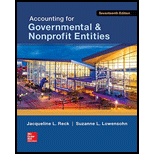
Explain the manner by which general long term liabilities are different from other long term liabilities and also explain the differences in financial reporting of general long term liabilities and other long term liabilities.
Explanation of Solution
The manner in which general long term liabilities are different from other long term liabilities is as follows:
General long term liabilities are an obligation that arises from financing activities such as issuance of bonds and notes and leases and are not reported as fund liabilities of a proprietary or fiduciary fund.
The “fund” long-term liabilities are an obligation that are incurred by a proprietary or fiduciary fund and for which debt service would be paid from that fund.
The differences in financial reporting of general long term liabilities and other long term liabilities are as follows:
General long term liabilities are reported in the Governmental Activities column of the government-wide statement of net position (
Want to see more full solutions like this?
Chapter 6 Solutions
Accounting for Governmental & Nonprofit Entities
- In the current year, Preston Manufacturing incurred $225,000 in actual manufacturing overhead cost. The Manufacturing Overhead account showed that overhead was overapplied in the amount of $12,000 for the year. If the predetermined overhead rate was $15.00 per direct labor-hour, how many hours were worked during the year?arrow_forwardI need guidance on solving this financial accounting problem with appropriate financial standards.arrow_forwardPlease explain the solution to this general accounting problem with accurate principles.arrow_forward
- I want to this question answer for General accounting question not need ai solutionarrow_forwardDenzel Corporation had $8.5 million in gross income, operating expenses of $2.3 million, paid $1.7 million in interest on $15 million borrowed, and paid a dividend of $1.2 million. What is Denzel Corporation's taxable income? a) $3.3 million b) $3 million c) $4.5 million d) $4 millionarrow_forwardI am looking for the correct answer to this general accounting question with appropriate explanations.arrow_forward
 Intermediate Accounting: Reporting And AnalysisAccountingISBN:9781337788281Author:James M. Wahlen, Jefferson P. Jones, Donald PagachPublisher:Cengage LearningPrinciples of Accounting Volume 1AccountingISBN:9781947172685Author:OpenStaxPublisher:OpenStax College
Intermediate Accounting: Reporting And AnalysisAccountingISBN:9781337788281Author:James M. Wahlen, Jefferson P. Jones, Donald PagachPublisher:Cengage LearningPrinciples of Accounting Volume 1AccountingISBN:9781947172685Author:OpenStaxPublisher:OpenStax College

